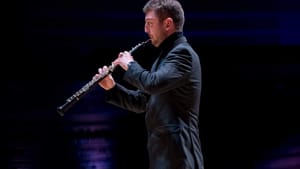The most elegant of instruments
The Philadelphia Orchestra presents its solo debut of new principal oboist Philippe Tondre

The Philadelphia Orchestra has had eight music directors in its 120-year history, and last year, it welcomed its eighth principal oboist. Philippe Tondre succeeded Richard Woodhams, who retired in 2018. Last week, streaming from the orchestra’s Digital Stage, Tondre had the opportunity to solo in the Mozart Oboe Concerto K. 314, the most celebrated of works for the instrument, with about two dozen of the orchestra’s musicians, and Yannick Nézet-Séguin at the podium. It was a worthy launch to what promises to be a long and fruitful partnership.
Highly regarded throughout Europe, the 31-year-old French musician is also principal oboist of the Chamber Orchestra of Europe, the SWR Symphonieorchester, and the Budapest Festival, Mito Chamber, and Saito Kinen orchestras, and has won numerous awards and accolades.
Mozart meets Tondre
Later refashioned by the composer into a concerto for flute, the Mozart work spans three movements in which the high-pitched solo woodwind cruises nimbly over the delightfully unfolding score for orchestra.
From the get-go, Tondre’s oboe sang a sweet, gentle song, emphasizing the clarity and cantabile qualities of the instrument. Listeners used to Woodhams’s more assertive playing will soon adapt to this smoother and lighter approach, as the artist himself adjusts to a new ensemble experience, not an easy task to achieve nor one to occur quickly. Tondre’s artistry extended to the three cadenzas in the concerto, which, according to a Philadelphia Orchestra spokesperson, he improvised—a choice that would have been typical in Mozart's time and that has been making a comeback after soloists' favoring composed cadenzas for many decades.
Specialists may debate the pros and cons of European- versus American-style embouchure, that upward turn of the lips which causes an oboist to smile like a cat; and whether the upper or lower lip should bear the pressure of the double-reed, and how much vibrato is enough. But for most lovers of music, what matters most is the keen, soaring tone of this most elegant of instruments, one that balances lightly on a thumb and spins breath into music with the grace of a hummingbird sipping the morning dew.
A heartfelt interpretation
It is amazing to consider how much great music the Philadelphians—scaled down in number but never better in terms of artistry—were able to pack into barely over an hour of playing time. The Mozart was preceded by the Symphony No. 2 in D major by Joseph Bologne, the Chevalier de Saint-Georges.
Saint-Georges (1745-1799) has come into his own with belated recognition as a major European composer of African ancestry. This is the first performance of this work by the Philadelphians, though not their first by this composer, who also served in the military and was a superior swordsman. He founded the Concert de la Loge Olympique, the ensemble that commissioned Haydn’s six Paris Symphonies (you can find Saint-Georges in Invictus, my novel about Beethoven’s childhood). The work is in three movements (fast, leisurely, and very fast), offering a rewarding journey through the peaceful world of classical harmony, so different from the world of revolution and the Reign of Terror through which the composer would live.
The program ended with one of Haydn’s more impassioned symphonies, the No. 44 in E minor (the “Trauersinfonie” or “Mourning Symphony”). Nézet-Séguin takes this music seriously and provided a heartfelt interpretation in which individual sections expressed deep feeling without resorting to romantic clichés not current in Haydn’s time. The sweeping pageantry of this small-scale work belies its size and harmonic simplicities and reminds us why Haydn remains in the canon of the greats.
Image description: Philippe Tondre, a 31-year-old white man with short brown hair, plays the oboe in a concert with the Philadelphia Orchestra. He’s shown in profile as he plays. He’s wearing a black suit.
What, When, Where
The Philadelphia Orchestra presents the Symphony No. 2 in D major, Op. 11, No. 2, by Joseph Bologne, the Chevalier de Saint-Georges; Wolfgang Amadeus Mozart’s Oboe Concerto, K. 314; and the Symphony No. 44 in E minor (“Trauersinfonie”) by Franz Josef Haydn. Philippe Tondre, oboist. Conducted by Yannick Nézet-Séguin. Streamed from Verizon Hall on January 14, 2021, via the Philadelphia Orchestra’s Digital Stage, with 72 hours of online access. philorch.org or (215) 893-1999.
Sign up for our newsletter
All of the week's new articles, all in one place. Sign up for the free weekly BSR newsletters, and don't miss a conversation.

 Linda Holt
Linda Holt